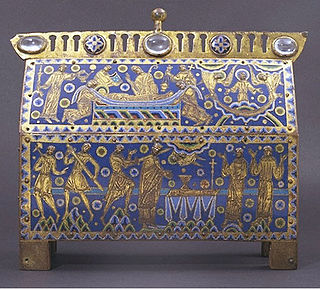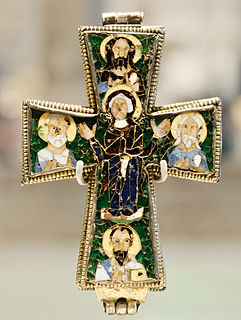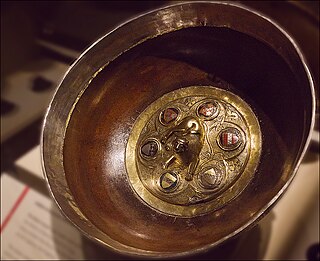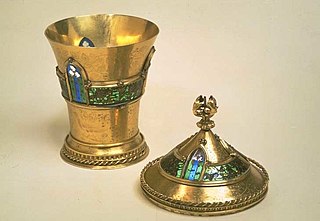 W
WThe Alfred Jewel is a piece of Anglo-Saxon goldsmithing work made of enamel and quartz enclosed in gold. It was discovered in 1693, in North Petherton, Somerset, England and is now one of the most popular exhibits at the Ashmolean Museum in Oxford. It has been dated to the late 9th century, in the reign of Alfred the Great and is inscribed "AELFRED MEC HEHT GEWYRCAN", meaning "Alfred ordered me made". The jewel was once attached to a rod, probably of wood, at its base. After decades of scholarly discussion, it is now "generally accepted" that the jewel's function was to be the handle for a pointer stick for following words when reading a book. It is an exceptional and unusual example of Anglo-Saxon jewellery.
 W
WThe Becket Casket is a reliquary in Limoges enamel now in the Victoria and Albert Museum. It is made of gilt-copper round a wooden core, decorated with champlevé enamel, and of a shape called a "chasse". It was made in about 1180–90 in Limoges, France, and depicts one of the most infamous events in English history. On the night of 29 December 1170, Archbishop Thomas Becket was murdered in Canterbury cathedral by four knights obeying the wishes of King Henry II. It provoked outrage throughout Europe, and pilgrims flocked to Canterbury to pray at the site of the murder. In 1173 Becket was canonized and his shrine was one of the most famous in the Christian world, until its total destruction in 1538 during the reign of Henry VIII. It is thought that this particular casket was made to hold the relics of Thomas Becket that were taken to Peterborough Abbey by Abbot Benedict in 1177. Benedict had been Prior at Canterbury Cathedral and therefore saw Becket's assassination.
 W
WThe Beresford Hope Cross is a 9th-century Byzantine reliquary cross with cloisonné enameling. It was intended to be worn as a pectoral crucifix, perhaps holding a fragment of the True Cross in the compartment inside. The cross is thought to have been made in southern Italy around the end of Byzantine iconoclasm, between 843 and the mid tenth century. It has been held by the Victoria and Albert Museum since 1886.
 W
WThe Bute Mazer, also known as the Bannatyne Mazer is a medieval communal feasting cup of a type known as a mazer. The wood bowl and the elaborate silver-gilt "boss" in the centre are dated "fairly firmly" to between 1314 and 1327 from the heraldry, with the rim and cover about 1500. It is the oldest Scottish mazer still surviving, and one of the oldest and most elaborate British ones. The cup has long been associated with the Isle of Bute, on the west coast of Scotland. Its alternative name derives from Ninian Bannatyne, Laird of Kames, who owned the cup in the 16th century and had his name engraved on the rim. The mazer is now on loan from the Bannatyne family to the National Museum of Scotland in Edinburgh.
 W
WThe Cellini Salt Cellar is a part-enamelled gold table sculpture by Benvenuto Cellini. It was completed in 1543 for Francis I of France, from models that had been prepared many years earlier for Cardinal Ippolito d'Este.
 W
WThe Cross of Mathilde is an Ottonian processional cross in the crux gemmata style which has been in Essen in Germany since it was made in the 11th century. It is named after Abbess Mathilde who is depicted as the donor on a cloisonné enamel plaque on the cross's stem. It was made between about 1000, when Mathilde was abbess, and 1058, when Abbess Theophanu died; both were princesses of the Ottonian dynasty. It may have been completed in stages, and the corpus, the body of the crucified Christ, may be a still later replacement. The cross, which is also called the "second cross of Mathilde", forms part of a group along with the Cross of Otto and Mathilde or "first cross of Mathilde" from late in the preceding century, a third cross, sometimes called the Senkschmelz Cross, and the Cross of Theophanu from her period as abbess. All were made for Essen Abbey, now Essen Cathedral, and are kept in Essen Cathedral Treasury, where this cross is inventory number 4.
 W
WThe Dagmar Cross is an 11th or 12th-century Byzantine reliquary cross made of gold with cloisonné enameling, traditionally thought to have belonged to Queen Dagmar, allthough it may just as well have belonged to her sister-in-law, Richiza, and now on display in the National Museum of Denmark. Replica of the cross are in Denmark traditionally given to girls in connection with their baptism or confirmation.
 W
WThe Dunstable Swan Jewel is a gold and enamel brooch in the form of a swan made in England or France in about 1400 and now in the British Museum, where it is on display in Room 40. It was excavated in 1965 on the site of Dunstable Friary, and is presumed to have been intended as a livery badge given by an important figure to his supporters; the most likely candidate is probably the future Henry V of England, who was Prince of Wales from 1399.
 W
WThe Cross with large enamels, or Senkschmelz Cross, known in German as the Senkschmelzen-Kreuz or the Kreuz mit den großen Senkschmelzen is a processional cross in the Essen Cathedral Treasury which was created under Mathilde, Abbess of Essen. The name refers to its principal decorations, five unusually large enamel plaques made using the senkschmelz technique, a form of cloisonné which looks forward to champlevé enamel, with a recessed area in enamel surrounded by a plain gold background, and distinguishes it from three other crosses of the crux gemmata type at Essen. The cross is considered one of the masterpieces of Ottonian goldsmithing.
 W
WThe Fieschi Morgan Staurotheke is a small reliquary designed to hold a relic of the true cross, it is 1 1/16 x 4 1/16 x 2 13/16 inches overall with lid. It is an example of Byzantine enameling. The box is dated to 843. Both dates hover around the second wave of Byzantine Iconoclasm from 814 to 842, allowing this piece to become a lens into the post iconoclastic art. These reliquaries doubled as an icon in style and purpose. The physical material of icons and the content within the reliquary were believed to contained a spirit or energy. It was believed that reliquaries contained great power, thus explains its preservation throughout the years. There are numerous theories of where this piece was created and its movement. It's currently on display at the Metropolitan Museum.
 W
WThe Holy Thorn Reliquary was probably created in the 1390s in Paris for John, Duke of Berry, to house a relic of the Crown of Thorns. The reliquary was bequeathed to the British Museum in 1898 by Ferdinand de Rothschild as part of the Waddesdon Bequest. It is one of a small number of major goldsmiths' works or joyaux that survive from the extravagant world of the courts of the Valois royal family around 1400. It is made of gold, lavishly decorated with jewels and pearls, and uses the technique of enamelling en ronde bosse, or "in the round", which had been recently developed when the reliquary was made, to create a total of 28 three-dimensional figures, mostly in white enamel.
 W
WThe Khakhuli triptych is a partially preserved large repoussé triptych icon of the Theotokos created in medieval Georgia. It incorporates over 100 specimens of Georgian and Byzantine cloisonné enamel dated from the 8th to the 12th century. The icon is now on display at Art Museum of Georgia in Tbilisi.
 W
WThe Khalili Imperial Garniture is a trio of cloisonné vases created for a Japanese Imperial commission during the Meiji era. The items were exhibited at the World's Columbian Exposition in Chicago, United States, in 1893, where they were described as "the largest examples of cloisonné enamel ever made". The decoration of the vases represents virtues and the seasons, and also has an allegorical meaning about Japan's role in a changing world and its alliance with the United States. After being exhibited, the vases were separated from each other for more than 120 years, eventually reunited in 2019 in the Khalili Collection of Japanese Art, a private collection assembled by the British-Iranian collector and scholar Nasser D. Khalili.
 W
WLustron houses are prefabricated enameled steel houses developed in the post-World War II era United States in response to the shortage of homes for returning G.I.s by Chicago industrialist and inventor Carl Strandlund. Considered low-maintenance and extremely durable, they were expected to attract modern families who might not have the time or interest in repairing and painting conventional wood and plaster houses. Lustron production ceased in 1950 due to the company's inability to pay back the startup loans it had received from the Reconstruction Finance Corporation. Over 2,000 homes were constructed during the Lustron's brief production period, and many remain in use today. Several have been added to the National Register of Historic Places.
 W
WThe Maschen disc brooch is an Early Medieval fibula, which was found in 1958 during archaeological excavations of the late Saxon grave field near Maschen, in the Lower Saxony district of Harburg, Germany. On its face side, the fibula shows an unidentified saint with a halo. It was found in a woman's grave of the beginning of the Christianization of northern Germany, and is in the permanent exhibition of the Archaeological Museum Hamburg in Harburg, Hamburg.
 W
WThe Mérode Cup is a medieval silver-gilt cup decorated with finely engraved birds, fruit and vine leaves made in France in Burgundy in about 1400 and named for the ancient Belgian family of Mérode, to whom it once belonged.
 W
WOld Woman Telling the Tale of Psyche is a plaque in grisaille painted Limoges enamel by Martin Didier Pape, showing an old woman telling a young woman the story of Cupid and Psyche. It was made in the Limousin region around 1580, copying an engraving of the scene by the 'Master of the Die'. The work's French inscription states it is "after a composition by Raphael" and also includes the artist's name. It has been in the Museum of Fine Arts of Lyon since 1851, whilst many of Pape's other works are in the Walters Art Museum in Baltimore, USA.
 W
WThe Royal Gold Cup or Saint Agnes Cup is a solid gold covered cup lavishly decorated with enamel and pearls. It was made for the French royal family at the end of the 14th century, and later belonged to several English monarchs before spending nearly 300 years in Spain. It has been in the British Museum since 1892, where it is normally on display in Room 40, and is generally agreed to be the outstanding surviving example of late medieval French plate. It has been described as "the one surviving royal magnificence of the International Gothic age". According to Thomas Hoving, former director of the Metropolitan Museum of Art in New York, "of all the princely jewels and gold that have come down to us, this is the most spectacular—and that includes the great royal treasures."
 W
WThe St. Mary's Abbey Figurine is a medieval gilt-copper alloy, Limoges enamel figurine found in St. Mary's Abbey, York in 1826. It was acquired by the Yorkshire Museum in 2019.
 W
WThe Staffordshire Moorlands Pan, sometimes known as the Ilam Pan, is a 2nd-century AD enamelled bronze trulla with an inscription relating to the forts of Hadrian's Wall. It was found in June 2003 in Ilam parish, Staffordshire, by metal-detectorists, and, in 2005, was bought jointly by the Tullie House Museum in Carlisle, the Potteries Museum in Stoke-on-Trent and London's British Museum, with the help of a grant of £112,200 from the Heritage Lottery Fund. It is a find of great national and international significance. The pan rotates between a number of locations, including the joint owning museums and another museum on Hadrian's Wall.
 W
WThe Stavelot Triptych is a medieval reliquary and portable altar in gold and enamel intended to protect, honor and display pieces of the True Cross. Created by Mosan artists—"Mosan" signifies the valley of the Meuse river—around 1156 at Stavelot Abbey in present-day Belgium. The work is a masterpiece of Romanesque goldsmith's work and is today in the Morgan Library & Museum in New York City.